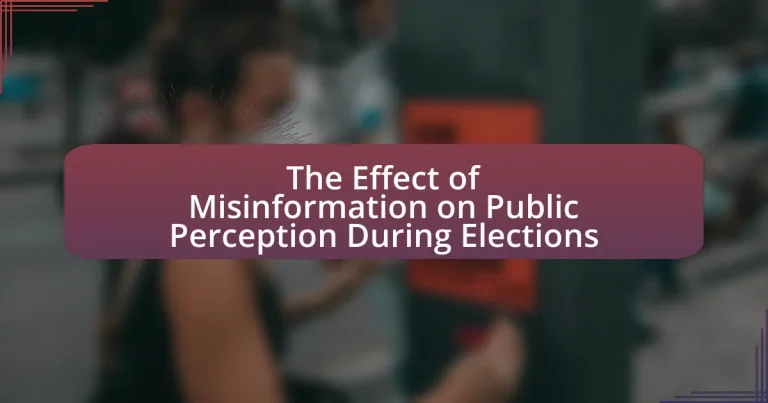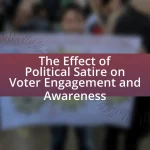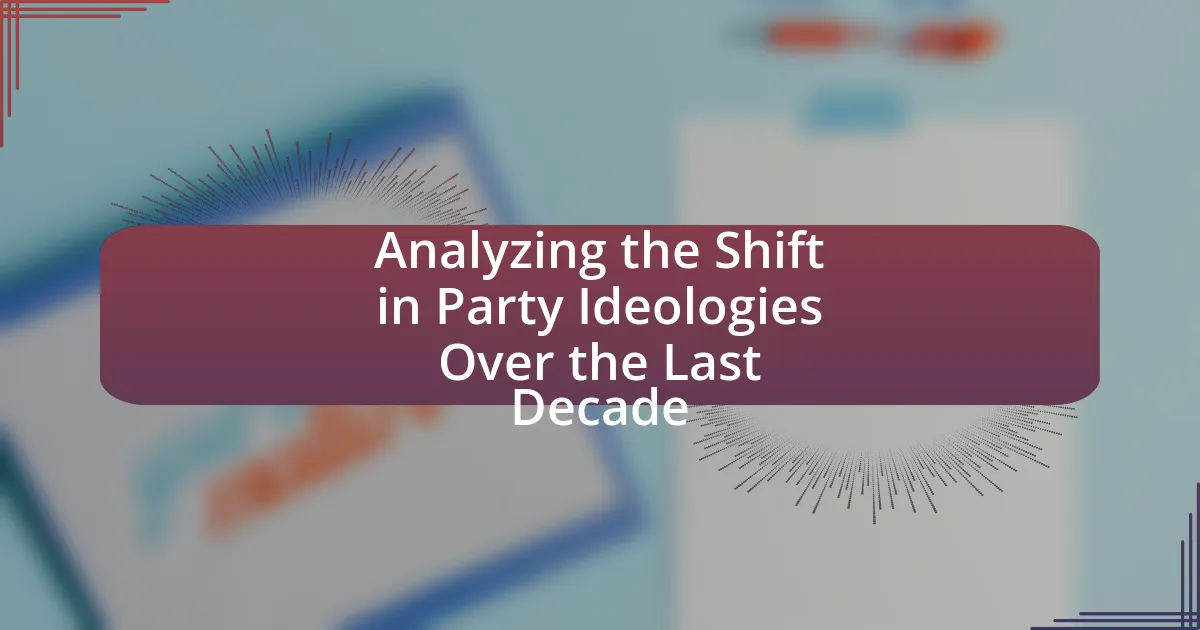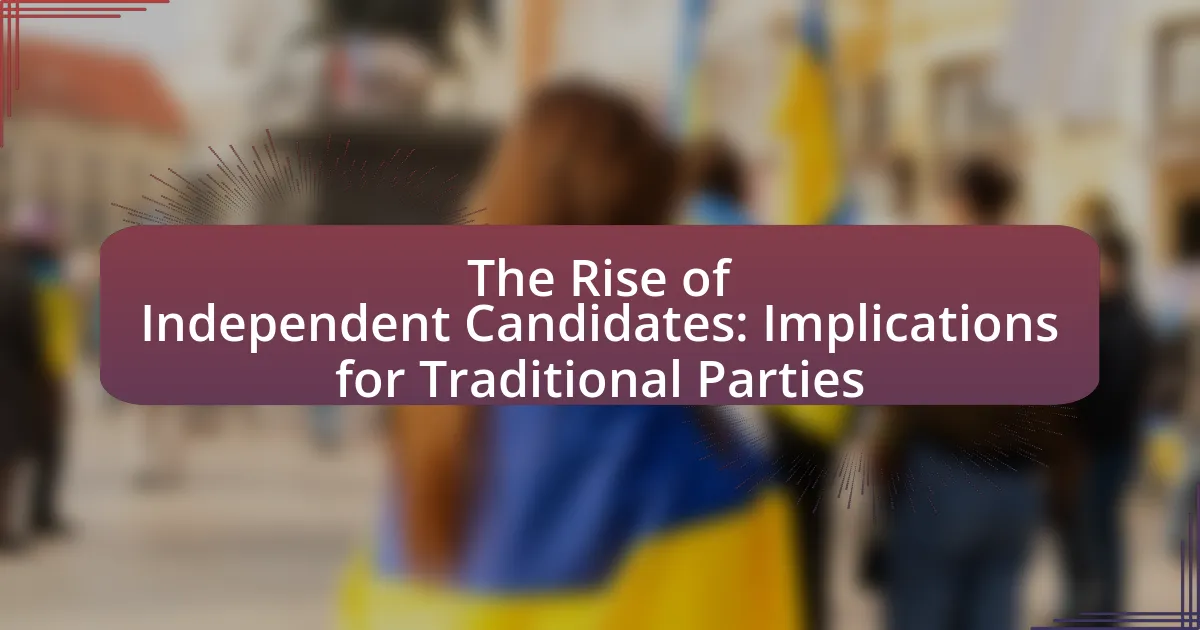The article examines the significant impact of misinformation on public perception during elections, highlighting how false information shapes voter beliefs and attitudes, leading to increased polarization and decreased trust in democratic institutions. It discusses the primary channels through which misinformation spreads, particularly social media, and the types of misinformation most prevalent during election periods. The article also explores the consequences of misinformation on voter turnout and election outcomes, emphasizing the importance of public perception and trust in shaping electoral behavior. Additionally, it outlines strategies to mitigate misinformation’s effects, including fact-checking initiatives and media literacy programs, while addressing the responsibilities of social media platforms in ensuring accurate information dissemination.

What is the effect of misinformation on public perception during elections?
Misinformation significantly distorts public perception during elections by shaping voters’ beliefs and attitudes based on false or misleading information. Studies have shown that exposure to misinformation can lead to increased polarization, decreased trust in media and institutions, and altered voting behavior. For instance, a 2020 study published in the journal “Political Communication” found that individuals who encountered misinformation were more likely to express negative views about candidates and political parties, ultimately influencing their electoral choices. This demonstrates that misinformation not only misguides public opinion but also undermines the democratic process by creating an informed electorate.
How does misinformation spread during election periods?
Misinformation spreads during election periods primarily through social media platforms, where false narratives can quickly gain traction. Research indicates that misinformation is shared more widely than factual information, with a study by Vosoughi, Roy, and Aral in 2018 revealing that false news stories are 70% more likely to be retweeted than true stories. This rapid dissemination is fueled by algorithms that prioritize engagement, often amplifying sensational content regardless of its accuracy. Additionally, coordinated efforts by political actors and bots can further propagate misleading information, creating echo chambers that reinforce false beliefs among targeted audiences.
What are the primary channels through which misinformation is disseminated?
The primary channels through which misinformation is disseminated include social media platforms, traditional news outlets, and messaging apps. Social media platforms, such as Facebook and Twitter, facilitate rapid sharing of false information, often amplified by algorithms that prioritize engagement over accuracy. Traditional news outlets can inadvertently spread misinformation through sensational reporting or lack of fact-checking. Messaging apps, like WhatsApp, enable private sharing of misleading content among users, creating echo chambers that reinforce false narratives. Research indicates that misinformation spreads more quickly on social media than factual information, highlighting the significant role these channels play in shaping public perception, especially during elections.
How do social media platforms contribute to the spread of misinformation?
Social media platforms contribute to the spread of misinformation by enabling rapid dissemination of false information to large audiences. Algorithms prioritize engaging content, often amplifying sensational or misleading posts over factual reporting. For instance, a study by the Massachusetts Institute of Technology found that false news stories spread six times faster than true stories on Twitter, highlighting the platforms’ role in facilitating misinformation. Additionally, the lack of stringent fact-checking mechanisms allows users to share unverified claims, further exacerbating the issue during critical periods like elections.
Why is public perception crucial during elections?
Public perception is crucial during elections because it directly influences voter behavior and decision-making. When voters perceive candidates positively, they are more likely to support them, as evidenced by studies showing that favorable public opinion can lead to increased voter turnout and candidate success. For instance, a Gallup poll indicated that candidates with higher favorability ratings often secure a larger share of the vote, demonstrating the tangible impact of public perception on electoral outcomes.
How does public perception influence voter behavior?
Public perception significantly influences voter behavior by shaping individuals’ opinions and decisions regarding candidates and policies. When voters perceive a candidate positively, they are more likely to support that candidate, as evidenced by studies showing that favorable media coverage can increase a candidate’s polling numbers. Conversely, negative perceptions, often fueled by misinformation, can lead to decreased support and voter turnout. For instance, research from the Pew Research Center indicates that misinformation can distort public understanding of candidates’ positions, ultimately swaying voter preferences and election outcomes.
What role does trust play in shaping public perception during elections?
Trust significantly influences public perception during elections by determining how voters interpret information and evaluate candidates. When trust in political institutions, media, and candidates is high, voters are more likely to accept information as credible and make informed decisions. Conversely, low trust can lead to skepticism, where voters may dismiss factual information and rely on misinformation or partisan narratives. Research indicates that in the 2020 U.S. presidential election, trust in media sources correlated with the acceptance of election-related information, impacting voter behavior and perceptions of legitimacy. Thus, trust acts as a critical filter through which electoral information is processed, shaping overall public perception.
What types of misinformation are most prevalent during elections?
The most prevalent types of misinformation during elections include false information about candidates, misleading claims about voting procedures, and fabricated statistics regarding voter turnout. False information about candidates often involves distorted facts about their policies or personal lives, which can significantly influence public perception and voter behavior. Misleading claims about voting procedures, such as incorrect deadlines or eligibility requirements, can create confusion and discourage voter participation. Fabricated statistics regarding voter turnout can manipulate public sentiment, leading to either inflated confidence in a candidate’s support or unwarranted fear of low voter engagement. Research by the Pew Research Center indicates that 64% of Americans believe misinformation has a significant impact on elections, highlighting the critical nature of these misinformation types.
What are the common themes found in election-related misinformation?
Common themes found in election-related misinformation include false claims about voter fraud, misleading information about candidates’ policies, and fabricated narratives regarding election processes. Research indicates that misinformation often exploits emotional triggers, such as fear and anger, to manipulate public perception. For instance, a study by the Pew Research Center in 2020 revealed that 70% of Americans encountered misinformation during the election cycle, with a significant portion focusing on exaggerated claims of voter fraud and misleading statistics about voter turnout. These themes not only distort the electoral landscape but also undermine trust in democratic institutions.
How does misinformation differ between local and national elections?
Misinformation in local elections often focuses on community-specific issues, while national elections typically involve broader topics that resonate across the country. Local misinformation may include false claims about candidates’ ties to the community or misleading information about local policies, which can significantly influence voter perceptions and turnout at the community level. In contrast, misinformation in national elections often revolves around larger themes such as immigration, healthcare, or economic policy, affecting a wider audience and potentially swaying national opinion. For instance, during the 2020 U.S. presidential election, misinformation about mail-in voting was prevalent nationally, while local elections saw misinformation about specific ballot measures or local candidates. This distinction highlights how the scope and impact of misinformation can vary significantly between local and national contexts.
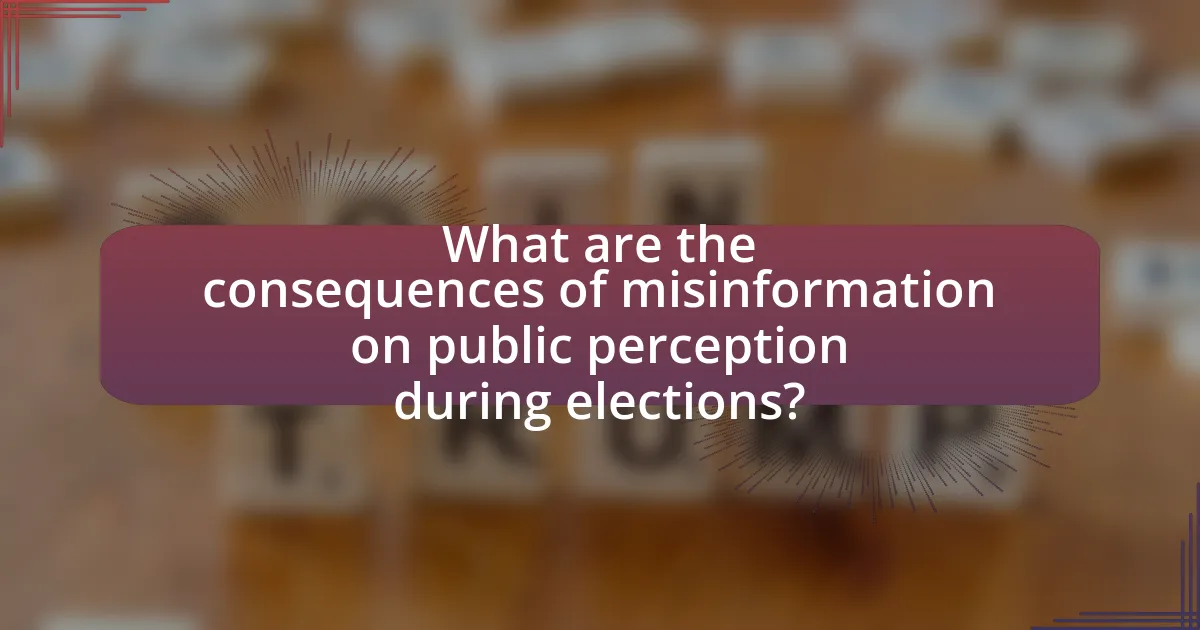
What are the consequences of misinformation on public perception during elections?
Misinformation during elections significantly distorts public perception, leading to misinformed voting decisions. Studies indicate that exposure to false information can alter voters’ beliefs about candidates and issues, often resulting in decreased trust in the electoral process. For instance, a 2020 study by the Pew Research Center found that 64% of Americans believed misinformation had a major impact on the election outcome. Furthermore, misinformation can polarize public opinion, creating divisions among voters and undermining democratic discourse. This effect is compounded by social media, where false narratives can spread rapidly, influencing large audiences before they can be corrected.
How does misinformation affect voter turnout?
Misinformation negatively affects voter turnout by creating confusion and distrust among potential voters. Studies indicate that exposure to false information can lead to decreased motivation to participate in elections, as individuals may feel uncertain about the legitimacy of the electoral process or their ability to vote effectively. For instance, a report by the Pew Research Center found that 64% of Americans believe misinformation has a significant impact on public confidence in elections, which can directly correlate with lower voter engagement.
What evidence exists linking misinformation to decreased voter participation?
Evidence linking misinformation to decreased voter participation includes studies showing that exposure to false information can lead to confusion about voting procedures and candidate positions. For instance, a study by the Pew Research Center found that 64% of Americans believe misinformation has a significant impact on their understanding of political issues, which can discourage them from voting. Additionally, research published in the journal “Political Behavior” indicates that individuals who encounter misinformation are more likely to report feeling disillusioned and less motivated to participate in elections. This correlation is further supported by data from the 2020 U.S. elections, where misinformation about mail-in voting led to a decline in participation among certain demographics, particularly among younger voters who were misled about the legitimacy of their ballots.
How can misinformation lead to voter apathy or disillusionment?
Misinformation can lead to voter apathy or disillusionment by creating confusion and distrust in the electoral process. When voters encounter false information about candidates, policies, or the voting process itself, they may feel overwhelmed and uncertain about their choices. This uncertainty can diminish their motivation to participate in elections, as evidenced by a study from the Pew Research Center, which found that 64% of Americans believe misinformation has a significant impact on public trust in government. Consequently, as trust erodes, individuals may disengage from voting altogether, believing their participation will not make a difference.
What impact does misinformation have on election outcomes?
Misinformation significantly impacts election outcomes by influencing voter perceptions and behaviors. Studies indicate that exposure to false information can lead to decreased voter turnout, altered candidate preferences, and increased polarization among the electorate. For instance, a 2020 study published in the journal “Nature” found that misinformation on social media platforms was associated with a 2-3% shift in voter support, which can be decisive in closely contested elections. Additionally, misinformation can create confusion about voting procedures, leading to disenfranchisement. The cumulative effect of these factors demonstrates that misinformation can undermine the integrity of electoral processes and distort democratic decision-making.
How can misinformation sway election results in favor of certain candidates?
Misinformation can sway election results in favor of certain candidates by shaping public perception and influencing voter behavior. For instance, false narratives about a candidate’s policies or character can lead to decreased support for their opponents, as seen in the 2016 U.S. presidential election where misleading information circulated widely on social media platforms. Research by the Pew Research Center indicates that 64% of Americans believe fabricated news stories cause confusion about the basic facts of current events, which can directly impact voter decisions. Additionally, misinformation can create a sense of urgency or fear, prompting voters to align with candidates who appear to offer solutions to fabricated crises. This manipulation of information ultimately distorts the democratic process, leading to outcomes that may not reflect the true preferences of the electorate.
What historical examples illustrate the impact of misinformation on elections?
Misinformation has significantly impacted elections throughout history, with notable examples including the 1932 U.S. presidential election and the 2016 U.S. presidential election. In the 1932 election, false claims about Herbert Hoover’s policies and the economic situation were disseminated, contributing to Franklin D. Roosevelt’s victory amid the Great Depression. This misinformation shaped public perception and voter behavior, illustrating how distorted narratives can influence electoral outcomes. In the 2016 election, the spread of fake news on social media platforms, particularly regarding Hillary Clinton’s health and the alleged connections between her campaign and various scandals, played a crucial role in swaying public opinion and voter turnout, ultimately benefiting Donald Trump. These instances demonstrate that misinformation can alter the course of elections by manipulating public perception and decision-making.
How does misinformation shape political discourse?
Misinformation shapes political discourse by distorting public understanding and influencing voter behavior. It creates confusion and polarization, leading to the spread of false narratives that can sway opinions and undermine trust in legitimate information sources. For instance, during the 2016 U.S. presidential election, studies indicated that misinformation on social media significantly impacted voter perceptions, with 62% of Americans getting news from social media, where false information proliferated. This manipulation of information can result in voters making decisions based on inaccurate or misleading data, ultimately affecting election outcomes and democratic processes.
What are the long-term effects of misinformation on political polarization?
Misinformation significantly exacerbates political polarization over the long term by reinforcing existing biases and creating echo chambers. Research indicates that individuals exposed to misinformation are more likely to adopt extreme political views, as they tend to seek out information that confirms their pre-existing beliefs, a phenomenon known as confirmation bias. A study published in the journal “Political Communication” by Vosoughi, Roy, and Aral in 2018 found that false news spreads more rapidly on social media than true news, leading to increased divisions among political groups. This persistent exposure to misinformation fosters distrust in opposing viewpoints and institutions, further entrenching partisan divides.
How does misinformation influence public trust in democratic institutions?
Misinformation significantly undermines public trust in democratic institutions by creating confusion and skepticism about their legitimacy. When citizens encounter false information regarding electoral processes, candidates, or government actions, it can lead to a perception that these institutions are corrupt or ineffective. For instance, a study by the Pew Research Center found that 64% of Americans believe misinformation has a major impact on public confidence in elections. This erosion of trust can result in lower voter turnout and increased polarization, as individuals become disillusioned with the democratic process.

What strategies can mitigate the effects of misinformation during elections?
To mitigate the effects of misinformation during elections, implementing fact-checking initiatives is essential. Fact-checking organizations, such as PolitiFact and FactCheck.org, actively verify claims made by candidates and political entities, providing voters with accurate information. Additionally, promoting media literacy programs equips citizens with the skills to critically evaluate sources and discern credible information from falsehoods. Research indicates that individuals exposed to media literacy training are better at identifying misinformation, thereby reducing its impact on public perception. Furthermore, social media platforms can enhance transparency by labeling or removing false content, as seen in efforts by Facebook and Twitter to combat misinformation during the 2020 U.S. elections. These strategies collectively contribute to a more informed electorate and help preserve the integrity of the electoral process.
How can media literacy improve public perception during elections?
Media literacy can improve public perception during elections by equipping individuals with the skills to critically analyze and evaluate information sources. This enhanced ability allows voters to discern credible news from misinformation, which is crucial in an era where false narratives can easily spread. For instance, studies show that individuals with higher media literacy are less likely to believe in false claims, as they can identify bias and recognize the tactics used in misleading information. According to a report by the Pew Research Center, 64% of Americans believe that misinformation has a significant impact on public opinion, highlighting the need for media literacy to counteract this effect. By fostering critical thinking and informed decision-making, media literacy ultimately leads to a more informed electorate, positively influencing public perception during elections.
What educational initiatives can help combat misinformation?
Educational initiatives that can help combat misinformation include media literacy programs, critical thinking courses, and fact-checking workshops. Media literacy programs teach individuals how to analyze and evaluate information sources, enabling them to discern credible news from falsehoods. Research by the Stanford History Education Group found that students who participated in media literacy interventions were better at identifying misinformation. Critical thinking courses encourage analytical skills that allow individuals to question the validity of information they encounter. Additionally, fact-checking workshops provide practical skills for verifying claims, which can significantly reduce the spread of false information. These initiatives collectively empower individuals to navigate the information landscape more effectively, particularly during elections when misinformation can heavily influence public perception.
How can critical thinking skills be fostered among voters?
Critical thinking skills can be fostered among voters through educational programs that emphasize media literacy and analytical reasoning. These programs can teach voters how to evaluate sources, discern credible information from misinformation, and understand logical fallacies. Research indicates that media literacy education significantly improves individuals’ ability to critically assess news content, as demonstrated in a study by the Stanford History Education Group, which found that students who received media literacy training were better at identifying misinformation. By implementing such educational initiatives, voters can enhance their critical thinking skills, leading to more informed decision-making during elections.
What role do fact-checking organizations play in addressing misinformation?
Fact-checking organizations play a crucial role in addressing misinformation by verifying claims made in public discourse, particularly during elections. These organizations assess the accuracy of statements from politicians, media, and social media, providing evidence-based evaluations that help inform the public. For instance, during the 2020 U.S. presidential election, organizations like PolitiFact and FactCheck.org published thousands of fact-checks, which contributed to a more informed electorate by clarifying misleading information. Their work not only debunks false claims but also promotes transparency and accountability, thereby fostering a healthier democratic process.
How effective are fact-checking efforts in changing public perception?
Fact-checking efforts are moderately effective in changing public perception, particularly during elections. Research indicates that exposure to fact-checking can reduce the belief in misinformation by approximately 20% to 30%. For instance, a study published in the journal “Political Communication” by Nyhan and Reifler (2010) demonstrated that individuals who encountered fact-checks were less likely to endorse false claims compared to those who did not. Additionally, fact-checking can enhance the credibility of information sources, leading to a more informed electorate. However, the effectiveness can vary based on factors such as the individual’s pre-existing beliefs and the perceived credibility of the fact-checking source.
What challenges do fact-checkers face in the current media landscape?
Fact-checkers face significant challenges in the current media landscape, primarily due to the rapid spread of misinformation across digital platforms. The prevalence of social media allows false information to circulate quickly, often outpacing fact-checking efforts. Additionally, the sheer volume of content generated daily makes it difficult for fact-checkers to verify every claim effectively. A study by the Pew Research Center found that 64% of Americans believe that misinformation is a major problem, highlighting the urgency for fact-checkers to address this issue. Furthermore, the increasing polarization of media sources complicates the fact-checking process, as audiences may dismiss corrections from sources they perceive as biased. These factors collectively hinder the effectiveness of fact-checking in combating misinformation during critical periods, such as elections.
What best practices can be adopted by social media platforms to reduce misinformation?
Social media platforms can adopt several best practices to reduce misinformation, including implementing robust fact-checking systems, enhancing user education, and improving content moderation. Fact-checking systems can involve partnerships with independent fact-checking organizations to verify the accuracy of information before it is widely disseminated. For instance, Facebook has collaborated with organizations like PolitiFact and FactCheck.org to assess the credibility of posts, which has led to a reduction in the spread of false information.
User education initiatives can empower users to identify misinformation by providing resources and tools that promote media literacy. Platforms like Twitter have introduced prompts that encourage users to read articles before sharing them, which can decrease impulsive sharing of misleading content.
Improving content moderation through the use of artificial intelligence and human oversight can help identify and flag false information more effectively. Research indicates that platforms employing a combination of automated systems and human reviewers can significantly reduce the visibility of misleading posts. For example, YouTube’s algorithm updates have been shown to decrease the reach of conspiracy theory videos by over 50%.
By integrating these practices, social media platforms can create a more informed user base and mitigate the impact of misinformation, particularly during critical periods such as elections.
How can algorithms be adjusted to limit the spread of false information?
Algorithms can be adjusted to limit the spread of false information by implementing stricter content moderation, enhancing fact-checking mechanisms, and prioritizing credible sources in information dissemination. Stricter content moderation involves using machine learning models to identify and flag misleading content based on established criteria, which has been shown to reduce the visibility of false information on platforms. Enhancing fact-checking mechanisms can involve partnerships with independent fact-checkers who assess the accuracy of information before it is widely shared, as evidenced by initiatives like Facebook’s third-party fact-checking program. Prioritizing credible sources ensures that information from verified and authoritative outlets is more prominently displayed, which can help guide users toward accurate information, as demonstrated by research indicating that users are more likely to trust information from reputable sources.
What responsibilities do social media companies have in ensuring accurate information dissemination?
Social media companies have the responsibility to actively monitor and regulate the content shared on their platforms to ensure accurate information dissemination. This includes implementing fact-checking mechanisms, flagging or removing false information, and promoting credible sources. For instance, during the 2020 U.S. presidential election, platforms like Facebook and Twitter introduced measures to combat misinformation, such as labeling misleading posts and directing users to authoritative information sources. These actions are crucial because studies indicate that misinformation can significantly influence public perception and voter behavior, as evidenced by research from the Pew Research Center, which found that 64% of Americans believe misinformation has a major impact on the political landscape.
What practical steps can voters take to protect themselves from misinformation?
Voters can protect themselves from misinformation by verifying information through credible sources before accepting it as true. This involves cross-referencing news articles with established fact-checking organizations such as Snopes or FactCheck.org, which have documented processes for debunking false claims. Additionally, voters should be cautious of sensational headlines and consider the source of the information, as studies show that misinformation often spreads through social media platforms where unverified content can go viral. Engaging in discussions with informed individuals and participating in community forums can also help voters gain diverse perspectives and clarify doubts about electoral information.
